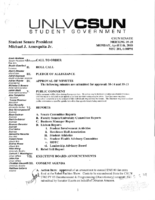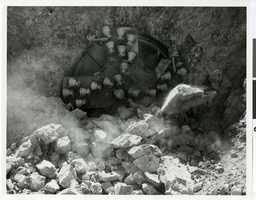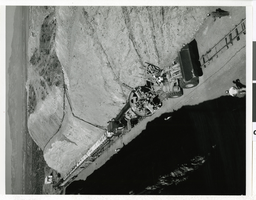Search the Special Collections and Archives Portal
Search Results
David A. Davis Collection of Aerial Photographs
Identifier
Abstract
The David A. Davis Collection of Aerial Photographs (approximately 1990-1999) contains seven black-and-white photographic prints and one black-and-white photographic negative of aerial views of Las Vegas, Nevada. These photographs are reproductions of originals obtained by David A. Davis from the Nevada Department of Transportation, the United States Geological Survey, and Landiscor Real Estate Mapping.
Archival Collection
Erni Cabat Art Prints
Identifier
Abstract
The collection consists of seven numbered art prints, hand signed by Arizona artist, Erni Cabat, with accompanying certificates of authenticity. The prints were created from original gouache paintings of scenes from casino life, and distributed by Nevada Magazine to mark the 50th anniversary of gambling in Nevada in 1981.
Archival Collection
Carratelli Family Collection on Gay Rights in Nevada
Identifier
Abstract
The Carratelli Family Collection on Gay Rights in Nevada (1992-2002) consists of documents and ephemera from various gay rights organizations and events in Las Vegas, Nevada. In addition to documents, fliers, and meeting minutes, the collection houses a box of t-shirts from various gay events and campaigns. The collection is especially focused on issues of Gay Pride organizing.
Archival Collection
Benjamin F. Smith Papers
Identifier
Abstract
The Benjamin F. Smith Papers, dated from 1960 to 1969, contains a photocopy of a typed manuscript written by Benjamin F. Smith titled "Lady Luck and I." The manuscript details Smith's life, and focuses mainly on his time in Las Vegas, Nevada and his gambling strategies. The manuscript also contains gambling plays, figures, and charts. The collection also contains photocopied newspaper clippings and a brief biography of Smith written by Larry Evans.
Archival Collection
Howard Schwartz Collection on Gaming
Identifier
Abstract
The Howard Schwartz Collection on Gaming documents the gaming industry in the United States from 1966 to 2010. The collection includes manuscripts, periodicals, newspaper articles, ephemera, profit and probability profiles and a report from the National Gambling Impact Study Commission.
Archival Collection
Vicki Cassman Faculty Papers and UNLV Memorabilia
Identifier
Abstract
The Vicki Cassman Faculty Papers and UNLV Memorabilia (approximately 1980-2004) are comprised of commemorative University of Nevada, Las Vegas (UNLV) memorabilia and papers pertaining to UNLV's 25th and 40th anniversaries as well as a 30th anniversary video tape for the Moyer Student Union. The collection also contains papers from the Department of Anthropology and Ethnic Studies history project (ANT 410/610) commemorating UNLV faculty member Claude Warren. The memorabilia in the collection includes a commemorative mug, golf ball, playing cards, and a media kit for the Sam Boyd Stadium and the Thomas & Mack Center.
Archival Collection
Billie Milton Grace Photograph Collection
Identifier
Abstract
The Billie Milton Grace Photograph Collection, approximately 1948 to 1960, consists of twenty black-and-white photographic prints and negatives depicting images of downtown Las Vegas, Nevada, the annual Helldorado Parade, the Marion Hicks family, local labor union dinners, Thunderbird Hotel employees, and various hotels and casinos.
Archival Collection

Meeting minutes for Consolidated Student Senate, University of Nevada, Las Vegas, April 11, 2005
Date
Archival Collection
Description
Text

Photograph of the "Mole" Jarva Tunnel Borer breaking through the tunnel on the Las Vegas River Mountain Project, Las Vegas, Nevada, circa 1968-1971
Date
Archival Collection
Description
Image

Photograph of the 988 caterpillar loader towing mole and conveyor to the tunnel portal used on the Las Vegas River Mountain Project, Las Vegas, Nevada, circa 1968-1971
Date
Archival Collection
Description
Image
